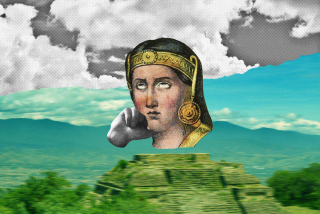Whether the voyage of Christopher Columbus 500...
- Share via
Whether the voyage of Christopher Columbus 500 years ago was a leap forward in the progress of civilization or simply a visit to the New World by a band of pillagers and terrorists, depends on one’s point of view.
But it is possible to see the benefits and the harm that grew out of the Spanish-backed exploration of the Americas in a new exhibit at the Huntington Library in San Marino. Entitled “Spain in the Americas, 1492-1600: What Is the Legacy?” the exhibit contains rare books, maps and manuscripts.
Documents include a letter written by Columbus to his son, Diego, shortly before the explorer’s fourth voyage in 1502. The letter, thought to be lost, was recently discovered in the Huntington, bound into a 17th-Century genealogical history.
The impact of the Spanish exploration on Europe’s understanding of the world is reflected in two maps in the exhibit--a 1482 map that seriously
underestimated the size of the oceans, and a 1599 map that is much closer to the maps in use today.
The exhibit contains documents that reflect the clashes between cultures in the New World and the Spanish and the controversy in Spain over treatment of American Indians.
In addition to seeing the items on display, exhibit visitors will be given access to a computer linkup with the Archivo General de las Indias in Seville, Spain’s preeminent historical archive. This will permit viewing of documents that ordinarily could be seen only by traveling to Spain.
The exhibit, which will continue through October, is funded by a $300,000 grant from a Spanish foundation.
The Huntington is open to the public from 1 to 4:30 p.m., Tuesday through Friday, and from 10:30 a.m. to 4:30 p.m. on Saturday and Sunday. Although admission is free, a donation of $5 per adult is suggested.
More to Read
Sign up for The Wild
We’ll help you find the best places to hike, bike and run, as well as the perfect silent spots for meditation and yoga.
You may occasionally receive promotional content from the Los Angeles Times.






